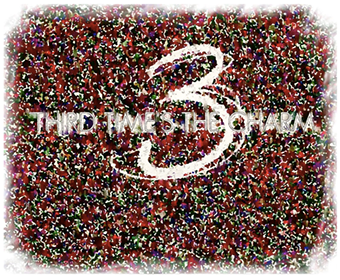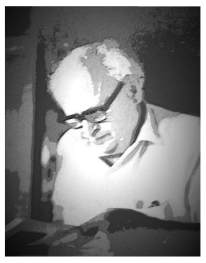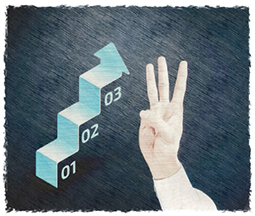
Third time’s the charm
In keeping with the commitment that I’d made to focus on the practice and teaching of Awareness Through Movement® lessons a couple of years ago, I started offering a new course, RETURNING TO THE SOURCE (RTTS), based on the question:
“What do I need to know about an ATM® to teach it well?”
Since then more than 250 Feldenkrais® teachers around the world have benefited from what this course has to offer.
Thing is, so has the course . . . and so have I.
One of the main reasons I am passionate about creating new curricula is that it sets the stage for learning from the course. I don’t yet know what the course has to offer or what I will learn from teaching it. That’s the most exciting — and, to be candid, the most nerve-wracking — aspect of offering a new course. It is also the most worthwhile because it’s how I, as an educator, learn and improve.
RTTS Version One
 The first editions of RETURNING TO THE SOURCE were a sort of online update of, and tribute to, the pioneering means of distance learning: the correspondence course. That’s because, while I taught the ATM lessons and gave presentations about them using the Zoom video service as a virtual classroom, all of the correspondence about the course — reminders of upcoming classes, notices that the recordings are available, homework assignments, and my responses to them — happened via email.
The first editions of RETURNING TO THE SOURCE were a sort of online update of, and tribute to, the pioneering means of distance learning: the correspondence course. That’s because, while I taught the ATM lessons and gave presentations about them using the Zoom video service as a virtual classroom, all of the correspondence about the course — reminders of upcoming classes, notices that the recordings are available, homework assignments, and my responses to them — happened via email.
If there’s one thing I’m pretty sure no one wants these days, it’s more email!? Not only that, but the deluge of email made it difficult to keep track of assignments, responses, and to find the links to the recordings. This was clearly everyone’s least favorite aspect of the course.
Not only did I find out how the mechanics of the program were working out but, by gauging responses and interacting — during live meetings and between them — with the participants, I learned how the material landed and found out how folks were benefiting from it. Though most of the participants were pleased and inspired, I wasn’t quite satisfied.
That’s because even though I’d done my level best to breakdown the conceptual models, identify the fundamental and necessary skills, and teach them incrementally, it turned out that the curriculum wasn’t quite making obvious some of the most critical elements, which were remaining elusive to too many of the participants for my satisfaction. For instance, some folks struggled to answer the very questions I (thought I) had designed the curriculum to answer:
- What’s the most important aspect of a lesson?
- How do you reliably and dependably remain consistent with this theme?
- What are the aspects of a lesson that you can change?
Which are the ones you can’t? (And why?)
It proved difficult for me to keep up with the participants’ emails, text messages, Facebook Messenger messages, Skype messages, and homework assignments, especially in the face of my other responsibilities, administrative and educational. When I was a lecturer in the Kinesiology Department at the University of Illinois at Champaign-Urbana, the students submitted a one-page homework assignment each week. That was back in the day before the ubiquity of email, not to mention the maddening multiplication of channels of communication.
Full disclosure: by the time we got to the middle of RTTS, I failed to keep up consistently. My mom was right! Sometimes, “my eyes are bigger than my stomach.” (I apologize to the participants for dropping the ball . . . and thank them for their kindness, understanding, and ongoing support!)
Working with the participants of the first five editions of the course gave me the chance to discover how the design worked and find out where it didn’t, and learn from failure, comments, suggestions, and feedback. That made it possible for me to, iteratively, refine the curriculum, the technology, and the ways the participants and I engaged in the course.
RTTS Version Two
 In January 2019 we offered RTTS VI, which also launched the updated 2nd version of course design. The experience from the first editions spurred me to add an online school to Mind in Motion’s website to make it more user-friendly. I revised the curriculum to present the content in a more graduated, incremental, engaging manner. I updated and improved the exercises and homework based on what I’d learned.
In January 2019 we offered RTTS VI, which also launched the updated 2nd version of course design. The experience from the first editions spurred me to add an online school to Mind in Motion’s website to make it more user-friendly. I revised the curriculum to present the content in a more graduated, incremental, engaging manner. I updated and improved the exercises and homework based on what I’d learned.
The school became the place for participants to find their homework assignments and respond to them as well as where they interacted with each other via the RTTS discussion forum.
The new curriculum worked better. However, while the new MIM Online School got rid of the email onslaught, the software was a bit too clunky and the way it worked wasn’t quite user-friendly enough. For RTTS VII, Trey, Mind in Motion’s web wizard, improved the discussion forum to make it easier to access and participate. (He also modernized the communication process by adding text message reminders for upcoming meetings.) To make it easier for them to access RTTS resources, each update also included links to upcoming classes, presentations, and Q&As as well as those for past sessions.
Along the way, I tried out different ways to engage participants with the homework and forum with admittedly varying success. I still struggled with keeping up with communication. More to my frustration and disappointment, involvement in the discussions and online exchanges too often was limited, with the same few people participating most of the time and me talking way too much.
What I learned last summer
My almost annual ATM summer camp this year, A Breath of Fresh Air, and the summer school for teachers that accompanied it gave me a chance to try out some approaches.
In keeping with Mind in Motion’s aim to not only provide ATM lessons and workshops but to also support students in taking their learning beyond the lesson, I expanded the scope of the homework. Each week included four parts:
- A second version of the lesson
- A doggie bag, which took a section of the lesson as basis for something to continue to work with during the days following the lesson
- An interactive exercise to share the learning from the class with other folks and do things we can’t do online.
- One or more video links to expand on the topics we’d addressed.
More importantly, I added a lab to accompany each ATM. Rather than leaving the transfer of learning — the greatest challenge in every educational approach — up tochance and the student’s habits, the labs took advantage of Zoom’s break out room feature, allowing the participants to do interactive exercises with each other to facilitate integration. This turned out to be more successful than I could have imagined; the participants experienced incredible, and incredibly meaningful, changes in their breath, voice, attitude, poise, and coordination.
 To increase the interaction amongst the teachers participating in the summer school, I made the sections smaller. We improved the design and functionality of the online lessons. I adopted a strategy like the one I deployed in the ATM labs: Instead of relying on the weekly homework tasks as the sole source of support, I incorporated breakout group exercises into the program. This gave the participants a chance to develop their observational abilities — what to notice about their students’ respiration and how to understand it — and teaching skills — what to do with what they perceive. Thankfully, this motivated everyone to share their experiences, challenges, and discoveries, making for more engaged and engaging conversations.
To increase the interaction amongst the teachers participating in the summer school, I made the sections smaller. We improved the design and functionality of the online lessons. I adopted a strategy like the one I deployed in the ATM labs: Instead of relying on the weekly homework tasks as the sole source of support, I incorporated breakout group exercises into the program. This gave the participants a chance to develop their observational abilities — what to notice about their students’ respiration and how to understand it — and teaching skills — what to do with what they perceive. Thankfully, this motivated everyone to share their experiences, challenges, and discoveries, making for more engaged and engaging conversations.
RTTS Version Three
Summer Camp and Summer School benefited from everything I’d learned from teaching RTTS, it’s the sequel, BEHIND THE CURTAIN, and LEARNING BEYOND THE LESSON (a few years ago). They also paved the way for the new, upcoming, third version of RETURNING TO THE SOURCE.
In the previous versions, I’d taught mini-workshops to give participants a sense of how the lessons could be taught in a compelling, significant series of ATMs. This time around, I’ve revised the order of the lessons. It’s no longer simply an interesting collection; the lessons are presented in a sequence where each one builds on what came before — both in terms of developing abilities and learning to learn. What’s more, this series leads to a meaningful and integrative close, making it an excellent basis for a workshop as well.
(When you sign up for the new edition — RTTS VIII! — you’ll also get access to the recordings of the previous workshops. At no extra charge. Whatsoever.)

Summer Camp and summer school debuted a newly redesigned and greatly upgraded, much more user-friendly Online School software. Version Two of RTTS was the introduction of the newest and best course redesign. Version Three combines both of these improvements to create a smooth interface, interactive curriculum, and more engaging course.
To encourage interaction between the participants and be true to our mission to foster communities of learners, I tried different ways of creating study buddies amongst the participants. This approach had some amazing successes and many disappointing shortcomings. This time around, RTTS includes a new feature: One Plus, which gives you the opportunity to share the course with your existing study buddy. (Again, at no extra cost. This feature is part of the package you’ve purchased. Period.) You’ll find more information about this on the MIMO website.
But wait . . .
In case you’re wondering,
“What about the participants of the previous versions?”
Rest assured. I’ve got their backs.
Now that we’ve got the technology updated, they’ll receive the recordings of the new ATM lessons at the same time as the participants do. And we’ll be making a self-paced version of the online labs and lessons available to them as well, most likely after RTTS VIII runs its course.
Access to future versions of the course comes with the package, too. Only seems fair, doesn’t it?

Your thoughts?
Please let us know your perspective! Add your comments, reactions, suggestions, ideas, etc., by first logging in to your Mind in Motion account and then clicking here.
Commenting is only available to the Mind in Motion Online community.
Join in by getting your free account, which gives you access to the e-book edition of Articulating Changes (Larry's now-classic Master's thesis), ATM® lessons, and more — all at no charge whatsoever.
To find out more and sign up, please click here.
Please share this blog post
 This work is licensed under a Creative Commons Attribution-ShareAlike 4.0 International License
This work is licensed under a Creative Commons Attribution-ShareAlike 4.0 International License
This blog may contain one or more affiliate links. When you click on a link and then make a purchase, Mind in Motion receives a payment. Please note that we only link to products we believe in and services that we support. You can learn more about how affiliate links work and why we use them here


Responses